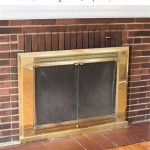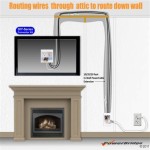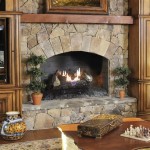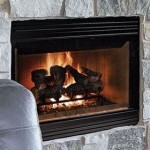The Purpose and Function of a Fireplace Chimney Damper
A fireplace chimney damper is a crucial component of a traditional masonry fireplace system. Its primary function is to regulate airflow within the chimney, controlling the entry of outside air into the house and the escape of smoke and combustion byproducts during fireplace use. Understanding the purpose and proper operation of a damper is essential for fireplace efficiency, safety, and overall home energy conservation.
The damper is typically a metal plate or door situated within the chimney flue, just above the firebox. It can be opened to allow smoke to vent upwards when a fire is burning, and closed to seal the chimney when the fireplace is not in use. This simple mechanism plays a vital role in preventing heat loss, minimizing drafts, and keeping unwanted elements from entering the home. The effectiveness of a damper, however, depends on its type, condition, and correct usage.
Preventing Heat Loss and Drafts
One of the most significant benefits of a properly functioning chimney damper is its ability to prevent heat loss. When a fireplace is not in use, the chimney acts as a large, uninsulated conduit that allows warm air to escape from the house. This phenomenon, known as the “stack effect,” occurs because warm air rises and creates a natural draft that pulls air upwards through the chimney. Without a closed damper, this constant outflow of warm air can significantly increase heating costs during the colder months. The open chimney essentially serves as a large hole in the roof, negating the insulation efforts applied elsewhere in the home.
Conversely, a closed damper also prevents cold drafts from entering the house through the chimney. During periods of cold weather, outside air can flow down the chimney, creating a noticeable draft that can make a room feel significantly colder. This draft can also contribute to uneven heating throughout the house, as cold air infiltrates near the fireplace while other areas remain warmer. By sealing the chimney, a damper minimizes these drafts, contributing to greater comfort and reduced energy consumption.
The material and construction of the damper also contribute to its effectiveness in preventing heat loss and drafts. Traditional cast-iron dampers, while durable, can still allow air to leak around the edges. Newer damper designs, such as top-mounted dampers with rubber gaskets, offer a tighter seal and provide greater insulation, minimizing air leakage and maximizing energy savings. Regularly inspecting the damper for damage, corrosion, or gaps is essential to ensure optimal performance. A damaged or poorly fitting damper will not effectively seal the chimney, negating its intended benefits.
Controlling Combustion and Smoke
During active fireplace use, the damper plays a vital role in regulating combustion and controlling the flow of smoke. The damper must be properly opened before lighting a fire to allow smoke and combustion gases to vent effectively upwards through the chimney. If the damper is closed or only partially open, smoke can back up into the room, creating a hazardous situation. This backdraft can expose occupants to harmful carbon monoxide, a colorless and odorless gas that can be fatal. Therefore, ensuring the damper is fully open before lighting a fire is a critical safety precaution.
The degree to which the damper is open can also influence the intensity of the fire. When the damper is fully open, more air is drawn into the firebox, which can increase the rate of combustion and produce a hotter fire. Conversely, partially closing the damper can restrict airflow, slowing the burn and reducing heat output. This control allows users to adjust the fire to their desired level of warmth and reduce the risk of overheating the room. However, partially closing the damper also increases the risk of incomplete combustion, which can lead to increased smoke production and the buildup of creosote in the chimney.
Creosote is a flammable byproduct of incomplete combustion that accumulates on the inner walls of the chimney. Over time, creosote buildup can become a significant fire hazard. Regularly inspecting and cleaning the chimney to remove creosote is essential for preventing chimney fires. Proper damper operation, including ensuring adequate airflow during combustion, can help minimize creosote buildup. A well-maintained chimney and a correctly adjusted damper contribute to a safer and more efficient fireplace experience.
Preventing Entry of Animals and Debris
Beyond energy conservation and combustion control, a chimney damper also serves as a barrier against the entry of animals and debris into the home. Chimneys can be attractive nesting sites for birds, squirrels, and other small animals. Without a closed damper, these animals can easily enter the chimney and potentially find their way into the living space. This can create a nuisance and, in some cases, pose a health hazard if animals carry diseases or parasites.
Similarly, a closed damper prevents debris such as leaves, twigs, and branches from falling into the chimney. This debris can accumulate at the base of the chimney and obstruct airflow, potentially leading to smoke backdrafts and increasing the risk of chimney fires. In some cases, accumulated debris can also attract moisture, which can damage the chimney structure over time. A damper, particularly a top-mounted damper with a mesh screen, provides a physical barrier that helps keep the chimney clear of obstructions and prevents animals from entering.
The effectiveness of the damper in preventing animal and debris entry depends on its design and condition. Top-mounted dampers, which are installed at the top of the chimney, typically offer a more robust barrier than traditional throat dampers. They often include a mesh screen that further prevents small animals and debris from entering. Regardless of the type of damper, regular inspection and maintenance are essential to ensure it is functioning properly and providing adequate protection. A damaged or corroded damper may not effectively seal the chimney, allowing animals and debris to enter.
In summary, the fireplace chimney damper is a multi-functional component that plays a critical role in home heating efficiency, safety, and overall maintenance. Its ability to prevent heat loss, control combustion, and deter animals and debris makes it an indispensable part of a traditional masonry fireplace system. Proper operation, regular inspection, and timely maintenance are essential to ensuring the damper functions effectively and provides the intended benefits. Ignoring the condition and function of the damper can lead to increased energy costs, potential safety hazards, and unnecessary maintenance issues.

The Purpose Of Your Chimney Damper Asheville Nc Environmental

Fireplace Flue Dampers Ensure Optimal On

How To Use A Fireplace Damper The Right Way

How Do Fireplace Dampers Work Zoro Com

Nicholas Chimney Sweeping Stove Fireplace Services Vienna Virginia

How To Open A Chimney Damper Traditional Fireplace Pros

Fireplace Damper Repair Full Service Chimney Kansas City

Flue Vs Damper Explained Fireplace Tips

Stop Losing Heat Up Your Fireplace Chimney Ohmefficient

Damper Repair Replacement Cherry Hill Mason S Chimney Serivce
Related Posts








